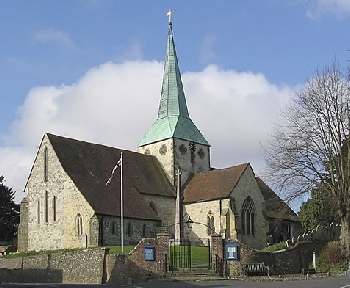



The Parish Church of St George the Martyr, Waterlooville

Christmas Edition 2010
Country Churches
126. St Mary & St Gabriel, South Harting
This cruciform 14th century church, with its green copper sheathed hexagonal spire, 130 feet high, dominates the High Street of the village. The spacious interior with its large central bell tower and two transepts is unusual for a village church.
The main feature of the nave is the large west window with its Victorian glass presented by Joseph Weaver in memory of Lady Fetherstonhaugh of Uppark House. The eight lights depict the Acts of Mercy -
The north transept with its plain windows is full of light and dominated by the large hanging figure of the Archangel Gabriel sculpted by Philip Jackson in 2009. Leading up to the bell tower is a magnificent oak spiral staircase built around an hexagonal centre post with cantilever steps and hand rail. It was designed and built by John Blackmore in 1852 and is a fine example of Victorian craftsmanship.
The south transept with its barrel vaulted roof is noteworthy for the large Elizabethan tomb of the Cowper family. John Cowper (d.1586) is shown reclining on a cushion holding a prayer book. Above is his wife, Margaret and at the top is father John Cowper kneeling at prayer. Alongside is the stone effigy of Sir Richard Caryll in armour. On the east wall of the transept is an interesting marble memorial to Roderick William Gordon who died in 1900 on board ship whilst returning home from India. He was buried at sea off St John’s island in the Red Sea. He was the fourth son of the vicar of South Harting. Standing on the floor below is a modern sculpture in bronze resin by Karin Jonzen of a Mother and Child.
The finest feature of the chancel is the magnificent wooden roof. Built after a severe fire in 1576 it has elaborate wall brackets, queen posts and carved bosses. The triple lanced east window is Victorian. On the south side is a 17th century arch containing memorials to the Ford family and also a mosaic depicting the Head of Christ. On the north wall is a board listing all the Hardy charities and a large stone memorial to Sir Henry Fetherstonhaugh of Uppark House who died in 1846 aged 92. He was the last of his line. Erected by his wife it shows her as a grieving widow with her dog at her feet.
All the pews in the nave are of Sussex oak and date from 1964. They are enhanced by a set of 193 kneelers stitched by parishioners between 1981 and 1993. In the north aisle an oak board lists all the vicars since 1182 including Reginald Pole (1526) a future Cardinal and Francis Salisbury (1690) who was executed in 1697 for coining. One very recent addition to the church is a spacious parish room adjacent to the south aisle. This was built in memory of Admiral Sir Horace Law and his wife Heather.
The churchyard is beautifully maintained and one section resembles being in a walled garden. Close to the church path leading up to the porch is a fine War Memorial designed by Eric Gill. It is of obelisk shape topped by a cross. At the base are carved panels showing St George and the Dragon, a bishop giving a blessing and Christ watching fishermen hauling in their catch. All the names from both wars are carved on three sides of the obelisk whilst the fourth side has an unusual text from 2 Maccabees 6 verse 31.
‘And thus they died leaving their deaths for example of a noble courage and a memorial of virtue not only to young men but unto all their nations.’
John Symonds
